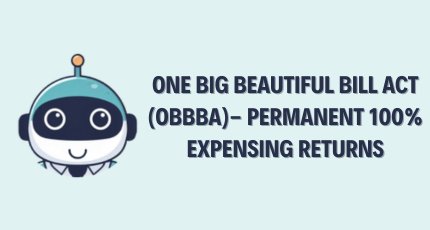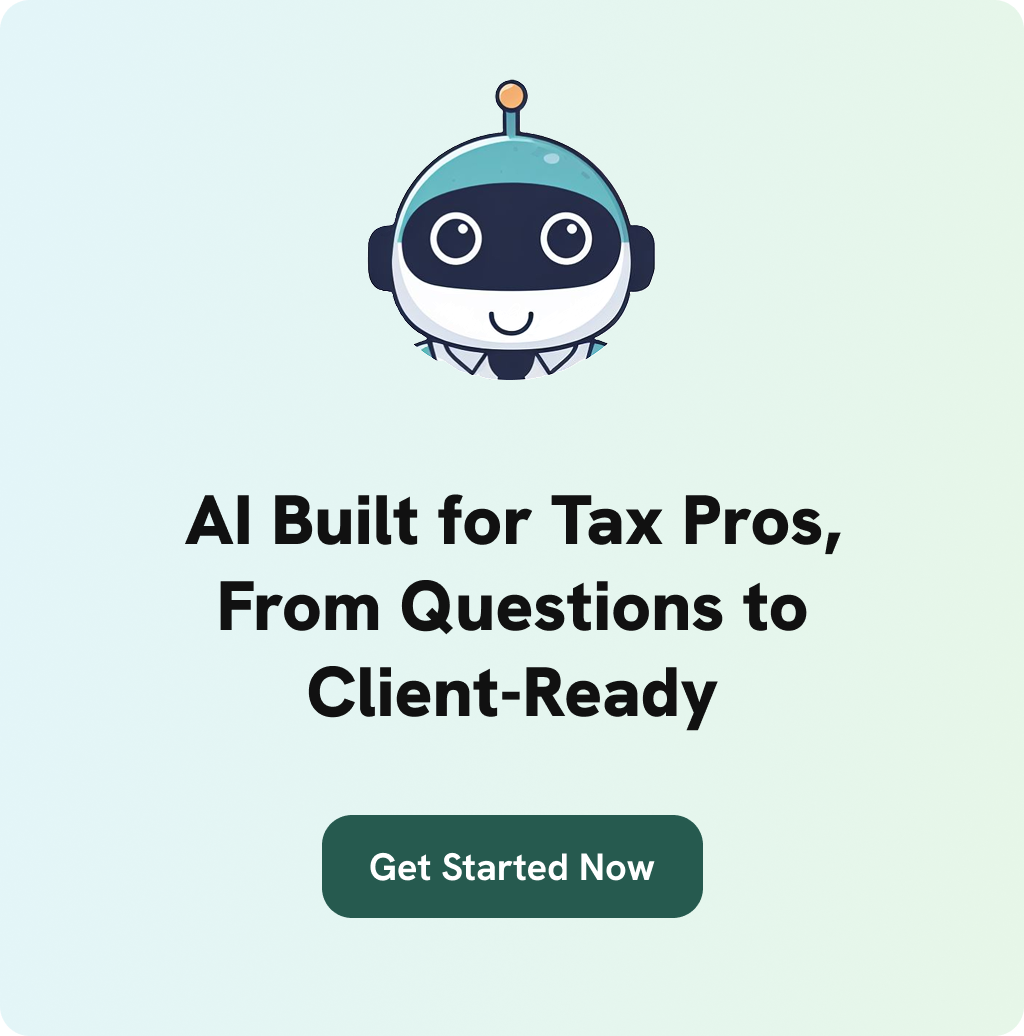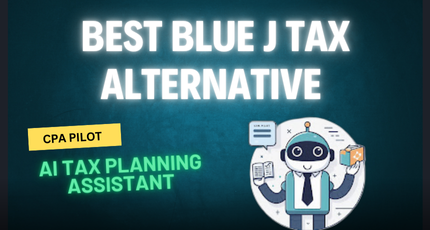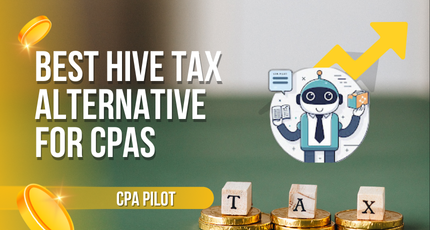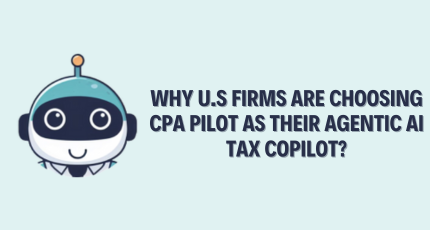Last-Minute Mid-Year & Year-End Tax Planning Using AI – [2025 GUIDE]
![Last-Minute Mid-Year & Year-End Tax Planning Using AI – [2025 GUIDE]](https://www.cpapilot.com/blog/wp-content/uploads/2025/09/Last-Minute-Mid-Year-Year-End-Tax-Planning-Using-AI.png)
[Last Updated on 1 day ago]
Looking to make tax-smart moves before the year ends?
CPAs can still deliver high-impact savings by using AI tools to accelerate complex tax planning—safe harbor tests, S-corp salary tuning, QBI optimization, PTE elections, capital gain harvesting, §179/bonus modeling, and clean energy credit checks—all modeled in minutes with client-ready documentation.
This guide shows how AI helps CPAs execute proactive tax strategies at two key timelines:
- Mid-Year (May–Sep): Course-correct with real-time estimates, plan elections, and cash-flow adjustments.
- Year-End (Oct–Dec / Jan 15): Lock in tax-saving actions before cutoffs with audit-ready documentation.
✅ Includes: AI-powered prompts, step-by-step workflows, client-facing memos, and compliance checklists.
📌 TL;DR – Last-Minute Tax Planning Using AI (Mid-Year & Year-End)
- AI now makes last-minute tax planning fast and accurate — even after mid-year.
- Use tools like CPA Pilot to:
- Run safe harbor vs. annualized penalty models.
- Optimize S-corp salary and QBI positioning.
- Check and execute PTE elections by state.
- Model §179 vs. bonus depreciation with cash-flow insight.
- Identify loss harvesting and wash-sale risks across accounts.
- Capture energy credits and batch charitable deductions.
- Includes:
- Prebuilt AI prompts, client-facing memos, and email scripts.
- Downloadable checklists for mid-year (May–Sep) and year-end (Oct–Jan 15) planning.
- Audit-ready outputs with citations, assumptions, and role-based workflows.
Table of Contents
- How AI Helps CPAs Tackle Last-Minute Tax Planning Challenges?
- Mid-Year vs. Year-End Tax Planning: What’s the Difference?
- The AI Advantage for Last-Minute Tax Execution
- Mid-Year Tax Planning with AI (May–September)
- Year-End Tax Planning With AI (October–January 15)
- Audit-Ready & Risk-Aware Tax Planning With CPA Pilot
- Why CPAs Should Use CPA Pilot for Mid-Year and Year-End Planning?
- FAQs- Mid-Year and Year-End Tax Planning With AI
- Downloadable Checklists
How AI Helps CPAs Tackle Last-Minute Tax Planning Challenges?
AI tax assistants like CPA Pilot reduce risk, improve speed, and support client outcomes when deadlines are tight and complexity is high.
Here’s how CPAs benefit from using AI during last-minute tax scenarios:
- Avoid penalties fast: Detect underpayments tied to volatile income, late K-1s, or missed estimates using automated safe-harbor testing.
- Handle workload overload: Let juniors follow structured AI workflows while partners approve in minutes.
- Manage multi-state complexity: AI maps PTE elections, SALT-cap workarounds, and conformity gaps by state.
- Navigate equity compensation rules: Flag wash-sale risks, coordinate RSU/ISO actions, and track NIIT/Alternative Minimum Tax (AMT) thresholds.
- Meet year-end cutoffs: Automate planning for bonuses, asset placements, donations, and DAF contributions before hard deadlines.
AI transforms last-minute pressure into structured execution with accurate prompts, real-time models, and client-ready outputs.
Mid-Year vs. Year-End Tax Planning: What’s the Difference?
Strategic tax planning hinges on timing. AI-powered workflows split the year into two distinct opportunity windows:
Mid-Year (May–September): Course-Correction Window
This is the ideal period to re-align financials, avoid penalties, and optimize deductions proactively. Common focus areas include:
- Adjusting estimates to avoid underpayment penalties
- Tweaking S-corp salaries to secure QBI treatment
- Maximizing retirement/HSA contributions before deadlines
- Electing PTE (pass-through entity) status while windows are still open
- Scheduling asset purchases for depreciation planning
Year-End (October–December, with a Jan 15 Extension): Finalization Window
Now is the time to lock in tax-saving moves before the clock runs out. These months focus on execution, documentation, and ensuring IRS/state compliance:
- Final W-2 bonuses and withholding adjustments
- Harvesting gains or losses before Dec 31
- Ensuring §179 assets are “placed in service” in time
- Securing energy efficiency credits
- Bunching charitable deductions or funding donor-advised funds
Key Planning Windows and Why They Matter?
- Quarterly Estimates: April 15 • June 15 • September 15 • January 15
These “pay-as-you-go” deadlines must be hit to avoid penalties. - Extension Filers (Oct 15): If an extension was filed, this is the paperwork deadline. Finalize memos, elections, and support files.
- Mid-Year (May–Sep): Optimize entity elections, compensation, and contribution strategies.
- Year-End (Oct–Dec): Execute final moves—bonuses, asset installations, donations, and realized gains/losses—before Dec 31 cutoffs.
How CPA Pilot Helps in Each Window?
Mid-Year (Fix the Course):
- Model safe harbor vs. annualized penalties
- Optimize S-corp compensation for QBI sweet spots
- Validate PTE eligibility and deadlines by state
- Compare Solo 401(k) vs. SEP setup and contribution timing
- Auto-pro-rate HSA limits and generate payroll changes
Year-End (Finish the Job):
- Tune year-end bonuses and withholdings to hit QBI targets
- Build a gain/loss harvest plan across all accounts with wash-sale checks
- Compare §179 and bonus depreciation impact with documentation guides
- Map energy credits and charitable timing for optimal deduction year
🡲 Schedule a CPA Pilot demo → see review gates, audit-ready packs, and workflow control.
The AI Advantage for Last-Minute Tax Execution
Traditional last-minute tax planning requires hours of data gathering, modeling, and drafting. CPA Pilot compresses this into minutes by automating every critical step—from intake to deliverables—while ensuring compliance-grade accuracy.
- Minimal Inputs → Maximum Clarity
AI only needs the essentials to model dozens of scenarios in minutes:
- YTD financials: P&L, balance sheet, payroll registers, withholdings, estimates
- Client profile: Entity type, state footprint, retirement/HSA status, coverage months
- Investments & equity comp: Realized gains/losses, RSU/ISO/NSO calendars
- Planned actions: Year-end bonuses, asset installs, charitable contributions
➡️ Just open CPA Pilot → auto-ingest the data → prefill scenario templates → review outputs.
- One-Click Scenario Modeling for Mid-Year & Year-End
AI delivers instant side-by-side planning with assumptions and tax code citations across:
- Penalty control: Annualized tax vs. prior-year safe harbor; estimate vs. W-2 withholding
- Comp/QBI: Salary vs. distribution bands; bonus targeting for 199A; audit-proof notes
- PTE elections: Eligibility, state deadlines, net tax savings after prepayments
- Gains/losses: Harvest plans, wash-sale risk checks, NIIT/AMT threshold modeling
- §179/Bonus: State/federal conformity, five-year cash impact, documentation checklist
- Energy credits: Credit mapping by specs; federal + state stacking; form references
- Prebuilt Drafts You Can Send Today
Every AI output is packaged into ready-to-send deliverables:
- Client memos: Purpose, assumptions, scenarios, deadlines
- Email templates: Approval notes, vouchers, payroll change instructions, trade orders
- Workpapers: Inputs, calcs, citations, tick marks, sign-offs
- Built-In Guardrails and Governance
AI-generated work stays compliant from the first click:
- Citations tied to Code, Regs, IRS Pubs, and state rulings
- Assumption logs for timing, payroll runs, and plan setup
- Role-based flows: juniors execute confidently, partners review and sign off fast
- Ready-to-Use AI Prompts for Tax Planning
Plug these into CPA Pilot’s planner to generate results on the spot:
- Safe Harbor:
“Compute annualized vs. prior-year safe harbor using YTD income/withholdings; output next payment to eliminate penalties and generate vouchers.”
- Comp/QBI:
“Compare $X/$Y salary bands for payroll taxes, QBI phase-ins, and audit-risk notes; recommend target band and draft payroll instruction.”
- PTE Elections:
“List PTE eligibility and deadlines for [states]; project SALT benefit net of entity-level tax and required prepayments; include election steps.”
- Harvest Plan:
“Identify loss lots up to $__, propose non-identical replacements, flag wash-sale risks across all accounts, and draft trader instructions.”
- §179/Bonus:
“Evaluate §179 vs. bonus for these assets; include state conformity, cash-flow impact, and placed-in-service documentation checklist.”
- Energy Credits:
“Screen planned upgrades against credit specs; show credit caps, interactions, and required ratings; include form references.”
🡲 Run these prompts inside CPA Pilot’s prebuilt planners with audit-grade outputs.
Mid-Year Tax Planning with AI (May–September)
The mid-year window is all about adjusting your course—fixing underpayments, maximizing deductions, and getting ahead of year-end bottlenecks. AI streamlines this process with built-in logic, guardrails, and automation. Here’s how CPA firms can take action now:
1. How Do We Control Penalties Fast with Safe Harbor & Annualization?
What to do now: Compare annualized current-year income against prior-year safe harbor thresholds (100%/110%). Decide whether it’s cheaper to increase W-2 withholding or make a Q3/Q4 estimated payment.
AI workflow: Ingest YTD financials and tax payments → Model annualized vs. safe harbor → Export estimate vouchers and memo.
Deliverables:
- Estimate voucher set
- Partner-ready tax memo
- Bookkeeper action list
AI prompt:
“Compute annualized vs. prior-year safe harbor using YTD income and withholdings; output minimum top-up to eliminate penalties and generate vouchers.”
2. How Should We Tune S-Corp Compensation to Protect QBI Mid-Year?
What to do now: Reassess reasonable compensation and adjust salary/distribution mix to stay within §199A thresholds, while managing payroll tax exposure.
AI workflow: Side-by-side salary scenarios → QBI phase-in/out modeling → Payroll instruction output.
Deliverables:
- Compensation scenario matrix
- Payroll change form
- QBI guardrail summary
AI prompt:
“Compare $X and $Y salary bands for payroll taxes, QBI deduction impact, and audit-risk commentary; recommend target band and generate payroll change request.”
3. Which Retirement Plan Moves Still Work Mid-Year? (Solo 401(k) vs. SEP vs. Cash Balance)
What to do now: Confirm eligibility and wages. Compare Solo 401(k) vs. SEP for total deferral space. Consider feasibility of adding a cash balance plan if high contributions are needed.
AI workflow: Prefill comp/ownership → Compute employee + employer limits → Build adoption timeline.
Deliverables:
- Plan comparison brief
- Setup calendar
- Payroll deferral schedule
AI prompt:
“Given wages of $__, compute max Solo 401(k) contributions vs. SEP; include setup deadlines, payroll dependencies, and contribution flow.”
4. How Do We Maximize HSA with Mid-Year Coverage Changes?
What to do now: Verify HDHP eligibility by month, coverage type (self/family), and catch-up availability. Pro-rate limits accordingly and adjust payroll.
AI workflow: Input coverage calendar → Auto-calculate limit and catch-up → Generate deduction update.
Deliverables: HSA proration worksheet
- Payroll update email
- Client memo
AI prompt:
“Pro-rate HSA contribution limit by HDHP eligibility months and coverage type; calculate catch-up and generate payroll instruction.”
5. Where Do PTE Elections Still Help This Year?
What to do now: Map out each operating/residency state’s election deadline and payment rules. Quantify potential federal SALT relief vs. entity-level tax cost.
AI workflow: Generate election map by state → Project benefit vs. cost → Draft resolution and payment schedule.
Deliverables:
- PTE eligibility table
- Prepayment amounts
- Board resolution template
AI prompt:
“List PTE eligibility and deadlines for [states]; project SALT benefit net of entity tax and required prepayments; recommend action with rationale.”
6. How Do We Shape Gains/Losses While Managing NIIT/AMT?
What to do now: Review realized gains, open lots, and equity comp vesting calendars. Design a tax-efficient harvest strategy while avoiding wash-sale violations and minimizing NIIT/AMT exposure.
AI workflow: Import all lots → Flag loss positions and replacement candidates → Output trader instructions with compliance checks.
Deliverables:
- Harvest plan
- Replacement ETF list
- Trader instruction email
- NIIT/AMT exposure sheet
AI prompt:
“Identify loss lots up to $__, flag wash-sale risks across accounts, and draft trader instructions. Test NIIT exposure and AMT triggers for RSUs/ISOs.”
7. Which Assets Should We Line Up for §179/Bonus at Year-End?
What to do now: Shortlist capital purchases. Evaluate §179 vs. bonus eligibility under state and federal law. Confirm vendors can install assets by Dec 31.
AI workflow: Upload asset list → Model §179 vs. bonus → Generate “placed in service” evidence checklist.
Deliverables:
- Side-by-side depreciation comparison
- Cash-flow projection
- Documentation pack (invoices, logs, install photos)
AI prompt:
“Evaluate §179 vs. bonus for listed assets; include federal/state conformity, phase-outs, and five-year cash flow; prepare placed-in-service proof pack.”
Mid-Year AI Planning: 60-Minute Execution
- Pull YTD ledger, payroll, brokerage, benefits, and state data
- Run core models: Safe Harbor → QBI → PTE (or Gains/Losses if investment-heavy)
- Generate client memo with assumptions, deadlines, and next steps
- Issue: estimate vouchers, payroll changes, PTE prepayments
- Calendar Sep 15 / Oct 15 checkpoints and assign follow-ups
Year-End Tax Planning With AI (October–January 15)
The final quarter is where tax planning turns into tax execution. Every action—bonuses, asset purchases, donations—must be timed and documented properly. AI helps CPAs lock in savings before deadlines hit, without missing compliance steps.
1. How Do We Finalize Payroll, Bonuses, and Withholdings to Lock QBI and Avoid Penalties?
What to do now: Calculate targeted W-2 bonuses to hit §199A deduction thresholds. Adjust withholdings on wages or retirement distributions to reduce underpayment penalties. Document “reasonable compensation” for audit readiness.
AI workflow: Model salary and bonus options → Evaluate QBI positioning and penalties → Generate HR/payroll instructions.
Deliverables:
- Bonus strategy sheet
- Withholding change form
- QBI guardrails memo
AI prompt:
“Optimize year-end bonus to fit within QBI thresholds; show payroll tax, 199A deduction, and audit flags. Compare W-2 withholding boost vs. Jan 15 estimate.”
2. How Do We Close the Book on Capital Gains/Losses Without Tripping Wash-Sale Rules?
What to do now: Harvest tax losses by Dec 31, ensuring replacement securities don’t violate the 30-day wash-sale rule. Sync RSU/ISO activity and manage exposure to NIIT and AMT.
AI workflow: Pull multi-account lots → Propose sell/buy pairs → Flag wash-sale risks → Output trader instructions.
Deliverables:
- Final harvest plan
- Replacement fund/ETF list
- Trader email instructions
- NIIT/AMT exposure summary
AI prompt:
“Identify loss lots up to $__ for Dec 31 harvest; recommend non-identical replacements; include wash-sale flags and NIIT/AMT modeling.”
3. How Do We Secure §179/Bonus by Proving ‘Placed in Service’ Before Dec 31?
What to do now: Confirm that qualifying assets are purchased, installed, and accepted before year-end. Choose between §179 and bonus depreciation based on cash flow and state conformity.
AI workflow: Compare §179 vs. bonus scenarios → Build install/vendor timeline → Generate documentation pack.
Deliverables:
- §179/bonus decision memo
- Five-year cash-flow model
- Evidence checklist (invoices, logs, photos)
AI prompt:
“Evaluate §179 vs. bonus for final purchases; account for state rules, phase-outs, and placed-in-service deadlines. Produce compliance-ready evidence pack.”
4. How Do We Capture Energy Credits (Business & Residential) Before Year-End?
What to do now: Validate project eligibility for federal and state energy credits (e.g., solar, EV chargers, HVAC). Gather specs and certifications before Dec 31.
AI workflow: Screen planned upgrades → Calculate stacked credits → List documentation and form requirements.
Deliverables:
- Eligibility matrix
- Credit calculation worksheet
- Installer/vendor request list
AI prompt:
“Screen upgrades for federal/state energy credits; include caps, spec requirements, and form references. Create documentation checklist for installer outreach.”
5. How Do We Coordinate Charitable Bunching and Donor-Advised Funds Without Derailing Cash Flow?
What to do now: Determine whether to itemize this year or next. Time DAF contributions and appreciated stock donations for tax impact and deduction optimization.
AI workflow: Model bunching scenarios → Recommend donation timing → Generate transfer and substantiation instructions.
Deliverables:
- Bunching strategy analysis
- DAF contribution memo
- Broker instruction letter
- Acknowledgment checklist
AI prompt:
“Model standard vs. itemized deduction with bunching this year; recommend DAF use, donation amount, and appreciated stock strategy. Draft custodian instructions.”
6. How Do We Choose Between Late-December Withholdings and the Jan 15 Estimate?
What to do now: Compare penalty impact between boosting withholdings on final W-2s or retirement payouts vs. making a standalone Jan 15 estimated payment.
AI workflow: Run both paths → Quantify interest/penalty differences → Output vouchers or withholding request.
Deliverables:
- Withholding change instructions or estimate vouchers
- Penalty cost comparison memo
AI prompt:
“Compare late-year W-2 or distribution withholding vs. Jan 15 estimate; recommend lower-penalty option with due dates and forms.”
Year-End AI Planning: 60-Minute Execution SOP
- Refresh YTD financials and projections
- Run three core models: Bonus/QBI → Harvest Plan → §179/Bonus
(Add Withholding vs. Jan 15 model if penalties loom) - Generate client-facing memo + task list (payroll, trades, installs, donations, vouchers)
- Issue instructions: HR/payroll, brokerage, vendor confirmations, DAF custodian
- Set Dec 31 deadlines and assign final reviews
Audit-Ready & Risk-Aware Tax Planning With CPA Pilot
Firms can’t afford uncertainty at year-end. Every recommendation must be supportable—every action, trackable. CPA Pilot is built for compliance-first execution, delivering outputs that hold up under scrutiny from both clients and auditors.
1. Citations and Compliance Built Into Every Output
Each deliverable includes direct references to IRS Code, Treasury Regs, IRS Publications, and applicable state guidance. No more scrambling for justifications during exam season.
- Code/Reg citations embedded in workpapers
- Assumptions clearly stated and timestamped
- State conformity rules and cutoff dates included
2. One-Click Audit Files With Evidence Packs
Generate a complete, indexed documentation bundle for every tax strategy—without extra work.
Included in the export:
- Workpapers with inputs, tie-outs, tick marks, reviewer initials
- Client communications (emails, memos, instructions)
- Calculations and scenario models with assumptions
- Evidence files: install logs, payment confirmations, photos
- Zipped and tagged for retention in your DMS
3. Logged Assumptions and Reviewer Trails
CPA Pilot auto-captures every relevant assumption, timestamp, and action taken:
- Payroll run dates and bonus authorization timelines
- Plan adoption and HSA coverage months
- Asset placed-in-service evidence and market thresholds
- PTE election timing and board resolution approvals
Each change is versioned, with a full reviewer audit trail and e-sign summary.
4. Evidence Without the Chase
Don’t wait for clients or vendors to send what you need. CPA Pilot prepares documentation kits and sends requests directly:
- Vendor install documentation packs
- Installer/spec certifications for energy credits
- Manager resolutions and election templates
- E-file receipts and timestamped payment confirmations
- Donation substantiation letters with IRS-compliant language
5. Role-Based Controls for Team Execution
Designed for firms, not individuals. Role-based permissions and built-in approval gates make execution safe and scalable:
- Assign tasks to juniors with workflow templates
- Require partner sign-off at key stages
- Auto-apply retention rules and access logs
- Protect client data with audit trail visibility
6. Plain-English Risk Language for Clients
Tax jargon won’t cut it. CPA Pilot automatically converts technical assumptions and caveats into plain English—so clients can approve with confidence, without misunderstanding risks.
Why CPAs Should Use CPA Pilot for Mid-Year and Year-End Planning?
When deadlines compress, capacity breaks. CPA Pilot turns that chaos into a repeatable, scalable process—so firms can deliver high-quality tax planning even in the final stretch of the year.
1. Make Every Week a Planning Week
CPA Pilot breaks the feast-or-famine advisory cycle. With built-in templates for mid-year and year-end tax scenarios, CPAs can launch planning deliverables weekly—without waiting for capacity.
- Templates for safe harbor, §199A, PTE, §179, energy credits, DAFs
- Pre-loaded assumptions and rules for federal and all 50 states
- Updated for timing cutoffs and eligibility windows
2. Run Scenarios Smarter With One Workspace
One interface. One client profile. Unlimited scenarios.
- Run safe harbor vs. annualized calculations in minutes
- Model S-corp salary bands to protect QBI
- Map PTE elections by state with cash impact
- Run gain/loss harvests with wash-sale screens
- Compare §179 and bonus depreciation with conformity checks
- Stack energy credits with form references and technical specs
CPA Pilot analyzes across rulesets and outputs side-by-side comparisons with assumptions and deadlines—ready to act on.
3. From Insights to Action in One Workflow
Most planning software stops at the model. CPA Pilot delivers what firms actually send:
- Estimate vouchers
- Payroll change orders
- Broker/trader instructions
- Vendor placed-in-service checklists
- Board resolutions
- Documentation kits
All exportable as a client memo, an internal workpaper, or a full audit file.
4. Built for Firms With Real Workflows
CPA Pilot supports teams—juniors, reviewers, partners—with workflows that enforce policy and accelerate delivery.
- Assign roles by user (e.g., preparer, reviewer, signer)
- Insert review gates for each output type
- Apply retention rules and generate access logs
- Version control with reviewer audit trail
Your firm’s SOPs are embedded into each step—no custom software build required.
5. Deliver Measurable Outcomes With the Same Team
CPA Pilot helps firms achieve:
- Fewer penalty notices and safer harbor misses
- Stronger QBI positioning and cleaner §199A support
- Faster decisions on PTE elections and SALT workarounds
- Compliant §179 and energy credit filings with evidence
- Shorter turnaround from model → memo → approval
All with the same team size.
FAQs- Mid-Year and Year-End Tax Planning With AI
Can I still reduce underpayment penalties after Sep 15?
Yes. Use annualized safe harbor calculations to re-test your penalty exposure. You can also increase late-year W-2 or retirement withholdings—often more effective than a Jan 15 estimate. CPA Pilot helps you compare both paths and choose the lower-cost option.
Is adjusting S-corp salary late in the year still worthwhile for QBI?
Yes, if done before final payroll. End-of-year bonuses or salary shifts can push taxable income back into the §199A deduction band—while maintaining reasonable comp standards.
SEP-IRA or Solo 401(k) if time is short?
A SEP is easier to set up late in the year. But Solo 401(k)s typically allow higher total deferrals if there’s W-2 income. CPA Pilot models both, factoring in deadlines, entity type, and payroll timing.
Do PTE (pass-through entity) elections still help this late?
Possibly. State deadlines vary. If your client still qualifies, CPA Pilot quantifies the SALT-cap benefit vs. entity-level tax and required prepayments—so you can decide quickly whether to proceed.
What must be done by Dec 31 to claim §179/bonus depreciation?
Assets must be “placed in service”—not just purchased. CPA Pilot generates documentation packs (invoices, install logs, photos) and timelines to meet this requirement.
Should I boost withholdings in late December or pay a Jan 15 estimate?
Run both paths. Late December W-2 or retirement withholdings are treated as if spread throughout the year and often reduce penalties more effectively than a single Jan 15 voucher.
How do I harvest losses without triggering wash-sale rules?
Sell loss positions and buy non-identical replacements. CPA Pilot checks across accounts (including spousal and retirement) and flags any trades that could violate the 30-day rule.
How do RSUs/ISOs affect NIIT and AMT at year-end?
RSU vesting adds to ordinary income and can trigger the NIIT. ISO exercises may cause AMT. CPA Pilot coordinates these with harvesting plans to maintain favorable thresholds.
Can charitable bunching or a donor-advised fund still help now?
Yes. Bunching deductions and gifting appreciated assets can boost itemized deductions and avoid capital gains. CPA Pilot helps model timing and draft custodian instructions.
What’s the quickest mid-year win for a volatile income client?
Start with safe harbor vs. annualization for penalty control. Then assess QBI banding and PTE elections if applicable. These moves have the fastest return on time and accuracy.
How do I document recommendations so they’re audit-ready?
CPA Pilot embeds all citations, logs assumptions, and compiles indexed workpapers. Deliverables include memos, evidence, and tie-outs—ready for client approval or exam defense.
Which moves carry into next year’s savings?
Discipline with quarterly estimates, fine-tuned S-corp compensation, steady HSA/retirement contributions, and early PTE decisions build compounding value into the next cycle.
Downloadable Checklists
Grab the printable checklists you can use with clients today. Keep both on hand—one for course‑correction mid‑year, one for year‑end execution.
These checklists are designed to support firms during crunch time—turning advisory insights into deliverables in under an hour.




